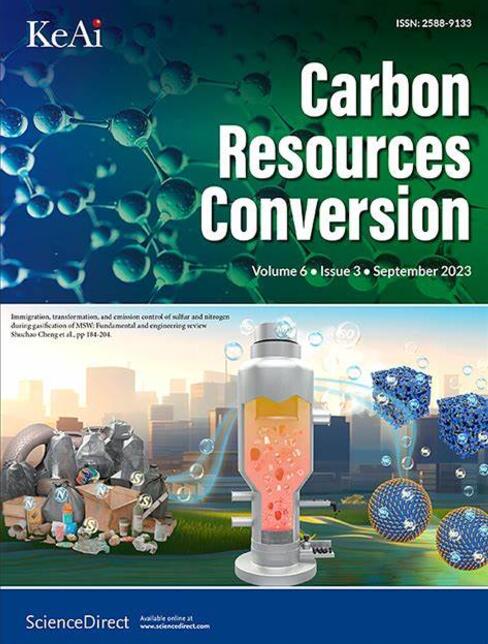通过单细胞油、磺化碳催化剂和生物柴油联产综合工艺实现甘蔗渣的价值化
IF 7.5
3区 环境科学与生态学
Q2 ENERGY & FUELS
引用次数: 0
摘要
研究了甘蔗渣(SB)转化为单细胞油(SCO)、磺化碳基催化剂和生物柴油的过程;这一过程符合废物转化为能源和循环生物经济的概念。用稀硫酸处理SB,得到SB水解产物(SBH)和SB固体残渣(SBS)。新分离的热带假丝酵母KKU-NP1在未解毒的SBH培养基中积累了26.5%的SCO含量。通过一步水热磺化法制备了一种新型碳基磺化催化剂(SBS@SC)。在直接酯交换最佳条件下,富sco的KKU-NP1湿电池转化为生物柴油(FAME)具有显著的催化活性,FAME的转化率为90.1%。根据FAME概况,FAME的大部分估计的物理化学和燃料性能都在ASTM D6751和EN 14214生物柴油标准的限制范围内。在综合工艺下,从1000 g原料SB中最终得到约12.0 g SCO、606.3 g SBS@SC催化剂和10.8 g生物柴油。本研究强调了SB作为低成本原料的利用,以生产多种增值产品,强调了通过综合生物炼制概念利用废物的优势,在整个生产过程中几乎不产生废物副产品。本文章由计算机程序翻译,如有差异,请以英文原文为准。

Sugarcane bagasse valorization through integrated process for single cell oil, sulfonated carbon-based catalyst and biodiesel co-production
This study demonstrates the conversion of sugarcane bagasse (SB) into single cell oil (SCO), sulfonated carbon-based catalyst and biodiesel; this process aligns with waste-to-energy and circular bioeconomy concepts. SB was treated with dilute sulfuric acid to achieve SB hydrolysate (SBH) and SB solid residue (SBS). Candida tropicalis KKU-NP1, a newly isolated yeast, accumulated SCO content of 26.5 % from undetoxified SBH medium. A novel sulfonated carbon-based catalyst (SBS@SC) was generated from SBS by a one-step hydrothermal sulfonation process. It showed significant catalytic activity for the conversion of SCO-rich KKU-NP1 wet cell into biodiesel (FAME) under direct transesterification optimal conditions, with a FAME conversion yield of 90.1 %. Based on FAME profile, most of the estimated physicochemical and fuel properties of FAME were within the limits of ASTM D6751 and EN 14214 for biodiesel standards. For integrated process the final production of about 12.0 g SCO, 606.3 g SBS@SC catalyst and 10.8 g biodiesel from 1000 g raw SB were achieved. This study highlights the utilization of SB as a low-cost feedstock for producing multiple value-added products, emphasizing the advantages of waste utilization by integrated biorefinery concept, yielding practically no waste by-products over the whole production process.
求助全文
通过发布文献求助,成功后即可免费获取论文全文。
去求助
来源期刊

Carbon Resources Conversion
Materials Science-Materials Science (miscellaneous)
CiteScore
9.90
自引率
11.70%
发文量
36
审稿时长
10 weeks
期刊介绍:
Carbon Resources Conversion (CRC) publishes fundamental studies and industrial developments regarding relevant technologies aiming for the clean, efficient, value-added, and low-carbon utilization of carbon-containing resources as fuel for energy and as feedstock for materials or chemicals from, for example, fossil fuels, biomass, syngas, CO2, hydrocarbons, and organic wastes via physical, thermal, chemical, biological, and other technical methods. CRC also publishes scientific and engineering studies on resource characterization and pretreatment, carbon material innovation and production, clean technologies related to carbon resource conversion and utilization, and various process-supporting technologies, including on-line or off-line measurement and monitoring, modeling, simulations focused on safe and efficient process operation and control, and process and equipment optimization.
 求助内容:
求助内容: 应助结果提醒方式:
应助结果提醒方式:


